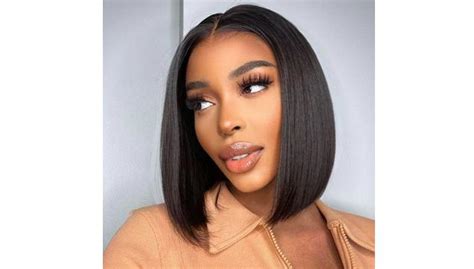As women over 60 embrace the natural aging process, they often explore new ways to enhance their appearance and boost their confidence. Wigs have emerged as a stylish and versatile accessory that can transform a woman’s look and alleviate common hair-related concerns. With so many options available, choosing the right wig can be overwhelming. This comprehensive guide will provide valuable insights into the world of wigs, empowering women over 60 to find the perfect styles that complement their beauty and personal preferences.

Understanding the Benefits of Wigs
Wigs offer numerous benefits for women over 60:
-
Natural Hair Loss Management: As we age, our hair can naturally thin and lose volume. Wigs can seamlessly conceal hair loss, providing a fuller and more youthful appearance.
-
Versatile Styling Options: Wigs come in a wide range of lengths, colors, and textures, allowing women to experiment with different hairstyles and achieve their desired look without committing to permanent changes.
-
Protection from Sun Damage: Extended sun exposure can damage natural hair. Wigs can shield the scalp and hair from harmful UV rays, preventing premature fading and breakage.
-
Confidence Boost: A well-fitting, stylish wig can instantly enhance self-esteem and confidence. By concealing hair loss or providing a new look, wigs empower women to feel more attractive and youthful.
Types of Wigs
There are three main types of wigs:
-
Human Hair Wigs: Made from 100% human hair, these wigs offer natural color, texture, and movement. While they are durable and versatile, they require more maintenance and can be expensive.
-
Synthetic Hair Wigs: Made from synthetic fibers, these wigs are available in a wider range of colors, styles, and textures. They are more affordable than human hair wigs but require less maintenance.
-
Lace Front Wigs: Constructed with a sheer lace forehead, these wigs create a natural-looking hairline. Lace front wigs offer more styling flexibility and a more realistic appearance.
Choosing the Right Wig
When selecting a wig, consider the following factors:
-
Face Shape: Determine your face shape (oval, round, square, heart) to choose a wig style that complements your features.
-
Lifestyle: Consider your daily activities and lifestyle when choosing a wig. If you lead an active lifestyle, a synthetic wig may be more suitable due to its low maintenance.
-
Budget: Wigs can range in price from affordable to high-end. Set a budget before shopping to narrow down your options.
-
Skin Tone: The color of your skin will influence the wig shade that best complements your overall look.
-
Hair Loss Pattern: If you have specific areas of hair loss, you may need a wig with a specific cap design to ensure a secure and comfortable fit.
Effective Strategies for Wig Maintenance
Maintaining your wig is crucial to preserve its appearance and longevity:
-
Regular Cleaning: Wash your wig according to the manufacturer’s instructions using a gentle shampoo and conditioner. Air dry the wig or use a low heat setting on a hair dryer.
-
Styling: Use a wide-tooth comb or wig brush to gently detangle the wig. Avoid using harsh chemicals or heat styling tools to prevent damage.
-
Storage: When not in use, store your wig on a wig stand or in a breathable container to prevent tangles and maintain its shape.
-
Regular Inspections: Regularly inspect your wig for any signs of damage or wear and tear. This will allow you to make necessary repairs or adjustments promptly.
Conclusion
Wigs offer women over 60 a versatile and stylish solution to address hair loss, enhance their appearance, and boost their confidence. By understanding the different types of wigs, considering their personal needs, and following effective maintenance strategies, women can find the perfect wigs that complement their beauty and individual style. Embrace the transformative power of wigs and enjoy the endless possibilities they offer.
Additional Tables
Table 1: Common Pain Points for Women Over 60 Regarding Hair
| Pain Point | Percentage of Women Affected |
|---|---|
| Thinning hair | 40% |
| Hair loss | 30% |
| Reduced hair volume | 50% |
| Graying hair | 90% |
| Damage from chemicals and styling | 35% |
Table 2: Motivational Factors for Choosing a Wig
| Motivation | Percentage of Women |
|---|---|
| To conceal hair loss | 60% |
| To experiment with different hairstyles | 40% |
| To protect hair from sun damage | 25% |
| To boost confidence | 65% |
| To feel more youthful | 30% |
Table 3: Comparison of Wig Types
| Feature | Human Hair Wig | Synthetic Hair Wig | Lace Front Wig |
|---|---|---|---|
| Material | 100% human hair | Synthetic fibers | Human hair or synthetic fibers |
| Texture | Natural | Variety of textures | Natural or synthetic texture |
| Color | Natural | Wide range of colors | Natural or synthetic colors |
| Durability | Durable | Moderate durability | Versatile, but may be less durable |
| Maintenance | High maintenance | Low maintenance | Moderate maintenance |
| Price | High | Affordable | Moderate |
Table 4: Tips for Choosing the Right Wig
| Factor | Tips |
|---|---|
| Face Shape | Oval: any style; Round: styles with height; Square: styles that soften the jawline; Heart: styles with volume around the temples |
| Lifestyle | Active: synthetic wig; Casual: human hair or synthetic wig; Professional: natural-looking, high-quality wig |
| Skin Tone | Fair: light blonde, medium brown, light auburn; Medium: medium brown, caramel, chocolate brown; Dark: dark brown, black, burgundy |
| Hair Loss Pattern | Circular: full cap wig; Diffuse: lace front or monofilament wig |
